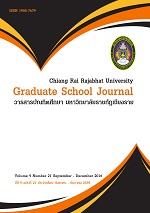汉语拼音书写规则研究及泰国学生使用汉语拼音书写规则偏误分析
Main Article Content
บทคัดย่อ
本论文的研究目的在于1)借鉴前人的研究成果,来系统地辨析整理汉语 拼音书写规则。2)以第二语言习得理论为理论背景,来考察泰国学生使用汉语 拼音书写规则的偏误情况,进行偏误分析及学习顺序研究。3)针对泰国汉语 拼音书写教学提出教学建议。本文使用问卷调查作为研究工具,选取泰国那空 拉差是玛皇家大学,汉语专业一年级到三年级的七十五名学生为调查对象, 每个年级二十五名学生。采用百分比计算方法对调查研究结果的数据进行统 计。
本论文通过借鉴前人的研究成果,系统地辨析整理了汉语拼音书写规则, 将之分类为9大类规则,56项细则。泰国学生学习汉语拼音书写规则偏误情 况的调查统计结果如下:一年级到四年学生级总错误率为47.78%。一年级学生 偏误率为48.58%,二年级学生偏误率为43.45%,三年级学生偏误率为46.72%。
泰国学生学习汉语拼音书写规则出现偏误的原因是多方面的,主要有以 下五个方面:一)汉语拼音书写规则本身复杂繁琐,难于理解和记忆。二) 教材编写问题。三)母语的负迁移。四)教学方法问题。五)学生背景知识 不足。针对泰国学生汉语拼音书写规则的教学建议。1)在编写针对泰国学生 学习的汉语教材时,参照本章的汉语拼音书写规则学习顺序,按照从易到难 的顺序。2)对于汉语拼音书写规则的教授,不应仅局限于低年级的基础汉语 课程内,或者只在第一个学期内学习,针对高年级学生的涉及汉语拼音书写 规则的课程中,教师也应插入汉语拼音书写知识的讲解和温习。3)汉语拼音 书写规则中汉语拼音变调标调规则“不、一”的标调规则、汉语拼音书写儿 化韵的规则和九汉语拼音书写隔音符号的规则,这些规则并不复杂难懂,学 生学习和理解起来并不难,但是仍容易出错。授课教师应多强调、多练 习。4)针对难点,设计专题介绍。5)加入中泰语言书写规则的对比,减少母 语的负迁移。
Chinese Pinyin Writing Rules Study on Errors of Thai Students Studying Chinese Major at Nakhon Ratchasima Rajabhat University
Presently, Chinese is one of the most important languages that has been increasingly used for communication. Hence, the number of Chinese as foreign language learners is also increased. For the beginners of Chinese phonetics, Pinyin is an essential tool in the learning process.
In Chinese learning and teaching field, many instructors and learners have not put the emphasis on Pinyin instruction. Pinyin consists of pronunciation and writing rules. Pinyin writing rule is significant and hard to understand.Thus, learners usually make frequent errors in this aspect. From this problem, the researcher focuses on Pinyin writing by Thai students. This study aimed at raising the awareness of both instructors and learners on the importance of Pinyin writing for the benefit of Chinese instruction in Thailand.
The objectives of this study were :1) To study and systematically gather Pinyin writing rules: 2) To study the problems in Thai students’ Pinyin writing: 3) To propose the solution for Thai students’ Pinyin writing.
Researcher studied and gathered Pinyin writing rules into 9 principal topics with 56 sub-topics. Questionnaires were used in this study to collect the data from the population and samples, 75 first to third year Chinese- major students from Nakhon Ratchasima Rajabhat University. The data was analyzed using percentage. The results showed that 47.78% of all 75 students had incorrect answers. Considering years of study in errors writing, the percentages were at 48.58 % for the first students, followed by 43.45% of the second year students, and finally, 46.72 % of the third year students respectively. Researcher ranked the difficulty levels of 9 principal Pinyin writing rules as follows:1) Pinyin writing rules consisted of very detailed sub-rules which were hard for students to understand and use correctly them. 2) Problems from course book and textbook that did not contain all the content and some were insufficient in both knowledge and details. 3) The native language (Thai) interference that Thai had different writing rules from Pinyin. 4) Problems from instruction that teachers overlooked were found in both beginners and advanced learners of Pinyin writing course that led to errors. 5) Pinyin writing rules consisted of many rules related to other courses namely, proverbs, literature, grammar, and commerce. The courses were intertwined and Pinyin beginners had insufficient knowledge about these courses, thus, led to misunderstanding about the rules. Followings are the recommendations from the researcher. 1) Textbook ,and books appropriate with Thai students should be complied by ranking from less complicated to the most complicated contents as stated in 9 principal topics of this study. 2) Pinyin teaching should not start exclusively for beginners, but advanced learners should be instructed for correct use of Pinyin. Contents should be integrated into other related courses, for example, personal name and country writing. 3) Some rules were not difficult, but the students were not taught before and these ruled were not focused in the course. These problems led to errors, to illustrate, sound change rules“不/一”. 4) For detailed and complicated rules, separated and continual writings, should be re-emphasized and given as example.5) The differences between Thai and Pinyin writing rules should be introduced to the learners to avoid the first language interference and Pinyin writing rules should be developed as one course in the curriculum.
Article Details
บทความที่ได้รับการตีพิมพ์เป็นลิขสิทธิ์ของวารสารมหาวิทยาลัยราชภัฎเชียงราย
ข้อความที่ปรากฏในบทความแต่ละเรื่องในวารสารวิชาการเล่มนี้เป็นความคิดเห็นส่วนตัวของผู้เขียนแต่ละท่านไม่เกี่ยวข้องกับมหาวิทยาลัยราชภัฎเชียงราย และคณาจารย์ท่านอื่นๆในมหาวิทยาลัยฯ แต่อย่างใด ความรับผิดชอบองค์ประกอบทั้งหมดของบทความแต่ละเรื่องเป็นของผู้เขียนแต่ละท่าน หากมีความผิดพลาดใดๆ ผู้เขียนแต่ละท่านจะรับผิดชอบบทความของตนเองแต่ผู้เดียว


